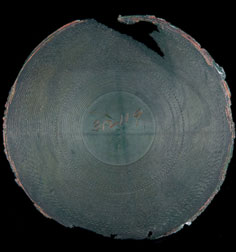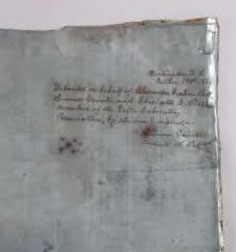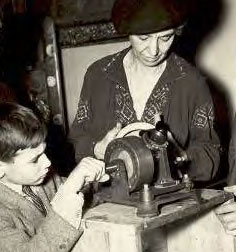
The Volta Laboratory and the Smithsonian
On three occasions—February 28, 1880; April 6, 1880; and October 30, 1881—the Volta Laboratory Associates delivered sealed tin boxes to the Smithsonian for safekeeping.
In addition to indicating Alexander Graham Bell’s high regard for the Smithsonian’s role in fostering science and technology, the deposit reflected his growing sensitivity to numerous challenges to his telephone patent. The confidential materials within these boxes could serve as evidence in case of a patent fight.
The first two boxes contained documentation for the photophone, a device to carry sound wirelessly on a light beam. Stowed in the third box was a copper recording and a new kind of sound recording and playback device, the graphophone.
The machine was a clear effort to improve on Thomas Edison’s tinfoil phonograph. In fact, the device contained in the box was an Edison phonograph, altered with widened grooves and a cylinder coated in wax onto which a vibrating stylus could inscribe a message. For playback, the machine aimed a fine jet of air at the record’s grooves through a rubber hose (not present) attached to a fitting behind the cylinder.
The tin boxes remained in a Smithsonian vault until 1937, when they were opened in the presence of Bell relatives. In later years the Smithsonian collections came to include hundreds of other experimental recordings and apparatus from the Volta Laboratory, donated by Bell to the Smithsonian in 1914 and 1915. Volta Associate Charles Sumner Tainter’s widow, Laura, donated his project notebooks.
Disc sound recording, copper electrotype copy of unknown original, for stamping out multiple recordings, deposited in October 1881
Speaker: unknown
Content: “[trilled r sound] One, two, three, four, five, six [trilled r sounds].”
Experiment goals:
• demonstrate that clear speech could be achieved with lateral recording—that is, engraving sound on the sides of a groove of varying widths, rather than up and down in a groove of varying depths
• prove that a copy could be made from another recording
Speaker: Alexander Melville Bell, father of Alexander Graham Bell
Content: “[trilled r sounds] There are more things in heaven and Earth, Horatio, than are dreamt of in our philosophy [trilled r sound]. I am a graphophone, and my mother was a phonograph.”
Experiment goals:
• show wax recording medium could yield clear speech
• achieve playback without touching the record to prevent the record’s deterioration
Opening the Volta Laboratory boxes at the Smithsonian, 1937 (Science Service photo courtesy of Smithsonian Institution Archives)
Opening the Volta Laboratory boxes at the Smithsonian, 1937. Left to right: Mrs. David Fairchild, Alexander Graham Bell's daughter Marian; Charles G. Abbot, secretary of the Smithsonian; Alexander Graham Bell Grosvenor, Bell's great-grandson; Mrs. Gilbert Grosvenor, Alexander Graham Bell's daughter Elsie May. (Courtesy of Library of Congress)





